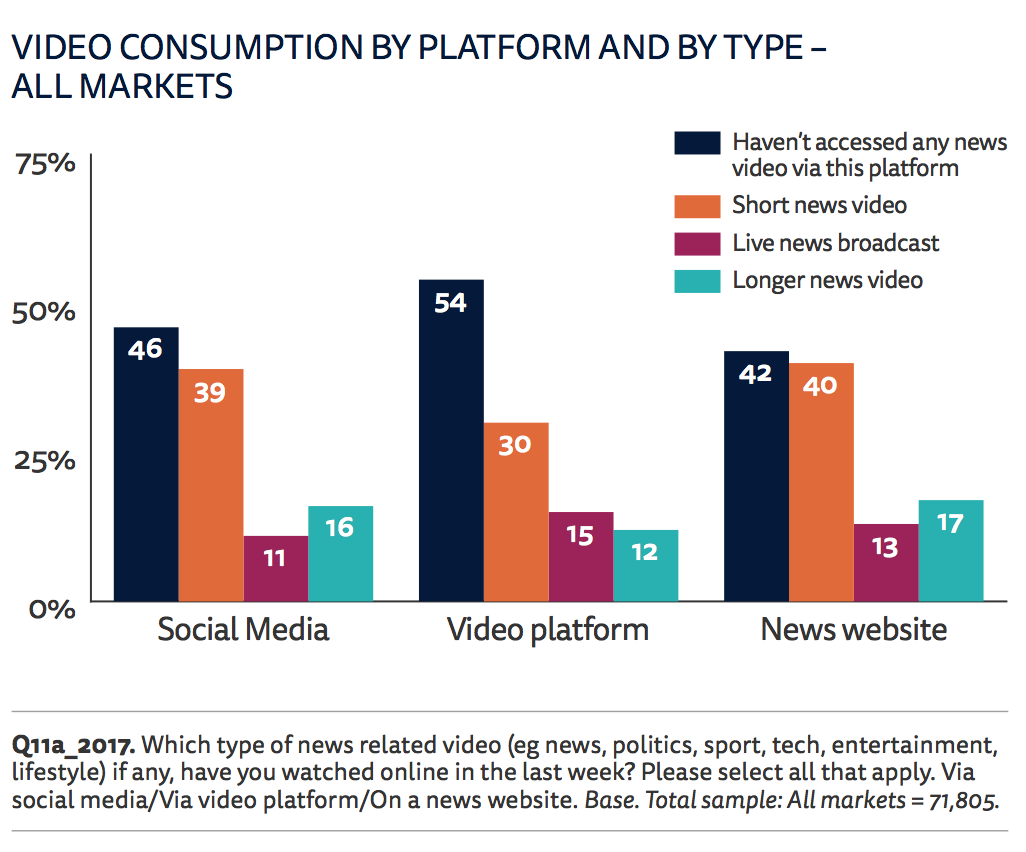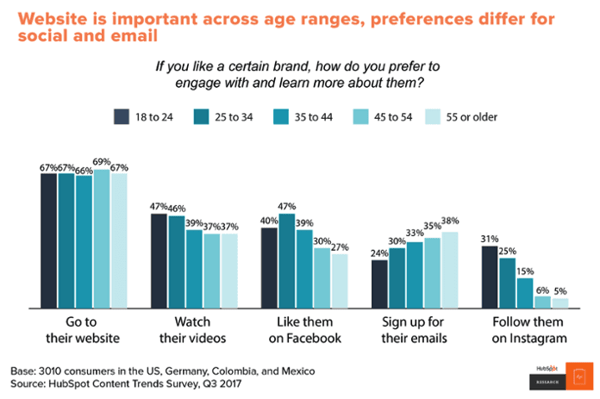When I read that the average American spends five-and-a-half hours per day watching video content, I scoffed. Between video explainers on Facebook, Game of Thrones, and Netflix, that average is closer to my daily minimum time spent watching videos.

After all, 2017 was “the year of video” -- why shouldn’t people consume more videos, and why shouldn’t creators make more?
As it turns out, there is such a thing as too much video. Publishers like MTV News, which laid off most of its editorial crew last year to focus on video; and Vox Media, which scaled back its video team this year, have seen how hazardous a "pivot to video" can be.

No, not that kind of pivot. I'm talking about the "pivot to video."
What is pivoting to video? It's not changing seats on the couch to get a better view -- it's the latest example of marketers and content creators being so eager to adopt a new platform or medium that they ruin it.
What Is a Pivot to Video?
Pivot to video (verb): To decrease or entirely shutter written editorial operations to focus on creating more video content
Synonyms: restructuring, reorganizing, refocusing
If this sounds like a joke ... well, the dictionary definition is kind of a joke. But "pivoting to video" consists of publications deciding to focus so entirely on video that entire writing and editorial staff are laid off completely.
It started with MTV News.
You might not be surpised to hear this -- after all, the word "television" makes up two of the three letters in MTV. But after an organizational restructuring at MTV in 2015, long-form editorial and video content about politics, culture, and social issues helped improve the network's ratings and engagement on web properties. MTV News staffed its team with content creators who produced documentary-style videos and 4,000-6,000-word long-form written pieces -- most of whom were let go in June of this year, when MTV News "pivoted" to create more short-form music and entertainment video over long-form editorial pieces.
Twitter was flooded with tweets from former employees announcing their newfound employment status, friends calling for publishers to hire them, and content creators from all media decrying -- and defending -- the strategic pivot.
I've been laid off by @MTVNews. I'll miss seeing my brilliant, talented colleagues, and I look forward to continuing my career elsewhere.
— Jamil Smith (@JamilSmith) June 28, 2017
.@MTVNews I'm a fan of video. I work in video. But behind strong video, you also need strong storytellers. https://t.co/LBgJZpi9mw
— Traci Lee (@traciglee) June 28, 2017
I’ve been in digital media for 12 years. One thing I’ve learned is that nobody wants to read anything over 1,000 words. MTV is more proof.
— Andy Gray (@AndyGray35) June 28, 2017
But the pivot didn't stop there.
Over the past year thus far, several major publishers have pivoted, structured, reorganized, and refocused on creating video content -- at the cost of writers' and editors' jobs. Sports Illustrated, Fox Sports, Vice, and HuffPost have all focused efforts on creating short-form video content -- and all have laid off writers and editors. One publication -- Vocativ -- laid off its entire editorial staff "to focus exclusively on video content."
In fact, "pivoting to video” has become such a ubiquitous term in the digital space that it’s become a joke in and of itself.
Quit doing this. No one wants video. We all read faster than people talk, it eats up data, and you can’t watch video on the toilet at work. https://t.co/cctmoHKiwz
— Peter Lynn (@Peter_Lynn) July 21, 2017
the WH communications department is pivoting to video
— Gideon Resnick (@GideonResnick) July 31, 2017
How’s that video push working out for everyone? - Vox Media Lays Off 50 Staffers, or 5% of Workforce https://t.co/wha3GyOVjo via @variety
— Merrill Barr (@MerrillBarr) February 21, 2018
Fast-forward to this year (no pun intended): Facebook announces it will reduce brand and publisher content on its users' news feeds, and Vox Media lays off 50 video producers across Racked, Curbed, SB Nation, and other online properties in its portfolio.
With respect to social media, snarky tweets from within the industry aren't the only reason to take your foot off the video gas pedal. There are a few big reasons a complete pivot to video is ill-advised. Keep reading -- I'll explain.
The Reason People Pivot to Video
Let's call a spade a spade -- publishers are pivoting to video to make money.
In the age of pre-roll and mid-roll advertising, it's harder to ignore a video ad when it's the only thing standing between you and a video you want to watch. Ads are easier to ignore when they live in the side margins and on top of written long-form articles, so publishers might see a greater opportunity to make money from placing video ads over video content.
And the biggest piece of the digital advertising pie now goes not to advertisers or publishers -- but to Facebook and Google. So it's understandable that media companies and publications are doing whatever they can to drive ROI on the content they produce.
But the pivot to video isn't happening at random -- these strategic reorganizations are also a nod to the growing popularity of video content, which we can't deny -- nor would we want to.
We've blogged at length about video being engaging, in-demand, and a smart way for brands to diversify content and connect with audiences in new ways. And making videos is smart -- it just shouldn't be the only content your brand produces.
It's true that videos are growing in popularity -- your audience wants to see videos, videos drive results for your business, and videos are an extremely favorable medium across different social media platforms. It's also true that the human attention span is waning. But this doesn't mean you should send your editorial staff packing. You don't need to "pivot to video" to develop a smart video strategy as part of your content production engine -- and we'll show you how.
What to Keep in Mind When Pivoting to Video
1. People Like to Read
Setting aside for a moment the fact that the written word has been in existence for several thousand years (thank you, Flinstone family), the popularity of video content and written content aren't mutually exclusive. In fact, audiences want more written content and more videos -- so can't we all just get along?
In 2017, we learned that roughly half of consumers want to see more video content -- but almost the same amount also wanted to see more news articles.
But in a new HubSpot Research survey released in February 2018, we learned that the popularity of video content is increasing -- especially among people 18 to 24 years old. What's a marketer to do?
Content consumption preferences are always changing, and they vary across different age groups, content formats, and subject matter. There are some cases when the written word is a better way to share information than video content -- especially as people are still browsing a business's website (and the written content included on it) more than purely video.
In some cases, audiences don't want videos at all. For example, in the United States, NiemanLab found that video isn't growing as rapidly as one might think.
In fact, roughly half of those surveyed didn't watch any online news videos -- and more than two-thirds said they consumed most news in text format. Most video being consumed was short and sweet and entertaining -- leaving plenty of room at the table for written content consumption, too.

So, people are watching videos, but they're also consuming a lot of text content, too. How should publishers and content producers address the diversifying content preferences of audiences?
The Solution
Make great videos and write great articles. In fact, ideally, you should be writing articles and reports, and then incorporating videos and other multimedia elements into them. Give the people what they want -- which is written, visual, and audio content.
Think about how your audience wants to learn. According to the survey above, people are more interested in consuming in-depth news information by reading it, whereas they might be more interested in watching shorter, more consumable video content. While a video might be a good fit for briefly explaining a complicated topic, it might not be the best fit for a detailed breakdown of SEO best practices -- like in these examples.
If you don't know the answer to this question, ask your audience. If you're not sure about your industry or audience's preferences, ask them. Using an email newsletter or a Twitter poll, ask questions like, "What would you most like us to produce a video about?" or "Do you prefer written or visual explainers?" to figure out where to get started.
The answer to the question of what types of content your audience prefers is an evolving one -- and one that we constantly experiment with here at HubSpot. Read about how we're changing up our social media video strategy in this blog post.
2. Videos Are Hard to Make
Videos are hard to make -- and it shows.
The internet is populated with far too many slideshows and photos set to music that are masquerading as videos -- like this one:
Videos like these don't offer the viewer much more value than reading a story would, but publishers keep making them -- presumably because they get more clicks on social media than an article would.
I don't know about you, but I find these videos extremely annoying -- they either autoplay when I open an article, or I click them to learn more and get no additional information out of them.
Instead, publishers and brands should be striving to make great videos -- which are driven by great stories. You need good storytelling to create a compelling video, and -- guess what? That will require the writing of a script or outline beforehand, and writers and editors can be of tremendous value there.
Additionally, if you remember our finding above, audiences don't just want one thing -- they want it all. Consumers want multimedia articles, in-depth research reports, blog posts, and entertaining videos. There's plenty of room for cross-collaboration between writers, editors, and video producers to create excellent content that solves for constantly-changing consumer preferences.
The Solution
Before implementing a video strategy, invest in resources to do it well, and experiment with creating different videos for different segments of your audience.
This means taking the time (and resources) to invest in video equipment, filming, and editing software, and freelancers or new employees who can make videos -- more specifically, who can make videos well.
By investing in video content up front, you'll ensure that your entire content production team is firing on all cylinders and creating video content that can both eventually rank in search results, and generate millions of views organically -- not just as an ad.
3. Videos Are Tough to Distribute
With the exception of a few major publications -- with content production budgets in the millions -- it's hard to crack the code of not only how to make great videos, but how to monetize them and use them to drive leads, customers, and revenue.
That's partly because digital video is such a new content medium, and content creators are figuring out how to make great videos (see above). It's also because Google search ranking factors and social media algorithms change so frequently, it's hard to nail getting videos surfaced and seen by people on different platforms. Facebook's shift to a more friends- and family-oriented news feed this year is a testament to this, and outlets like Vox Media know it all too well.
Plus, now that more people are jumping on the video content creation bandwagon, search engines and social networks are getting saturated with more videos to compete against.
So you might think that video creation is the hard part, but that's just the beginning. It takes concerted effort for videos to rank in YouTube and Google search results, or to rack up thousands and millions of views on Instagram and Facebook. And even if you do everything right, there could be a reason your audience doesn't want to watch your videos: They might not want to turn up the volume, they might be running low on their monthly data plan, or hey -- they could even be sitting on the toilet.
People have their preferences, and our recent survey above, we know consumers want to see video content alongside in-depth news articles and research content -- and that they want to watch videos on social media. People stream millions of hours of video content across social platforms every day, but these popular social videos might not generate leads at the speed a growing business needs.
The Solution
We suggest creating multimedia content that serves a variety of purposes on a variety of different platforms. For example, keyword-specific blog posts and YouTube videos might quickly rank in Google and YouTube searches, to help drive visitors to landing pages and lead forms that help brands start selling. On the other hand, entertaining, short-form videos on Facebook and Instagram will help spread a brand's message and attract more people to a website down the line.
If you're just getting started with video marketing, consider the type of video you should make first. Use them to help guide visitors along your marketing funnel -- alongside written content and offers to capture lead information.
Make specific types of videos for specific platforms in the same way you would for different types of written content. That way, the videos you create will have specific goals in mind -- for example, video views, video view rate, or website clicks -- that you can measure and iterate on.
Videos achieve outcomes on social media that written content might not, and written content can achieve search engine rankings that videos might not. The best scenario is to create both types of content -- along with multimedia content -- to meet audiences' ever-changing preferences, and to attract visitors and leads throughout the marketing funnel.
Images: Tumblr, HubSpot Research, NiemanLab






![How to Write a Video Script [Template + Video]](https://blog.hubspot.com/hubfs/video%20outline.png)







